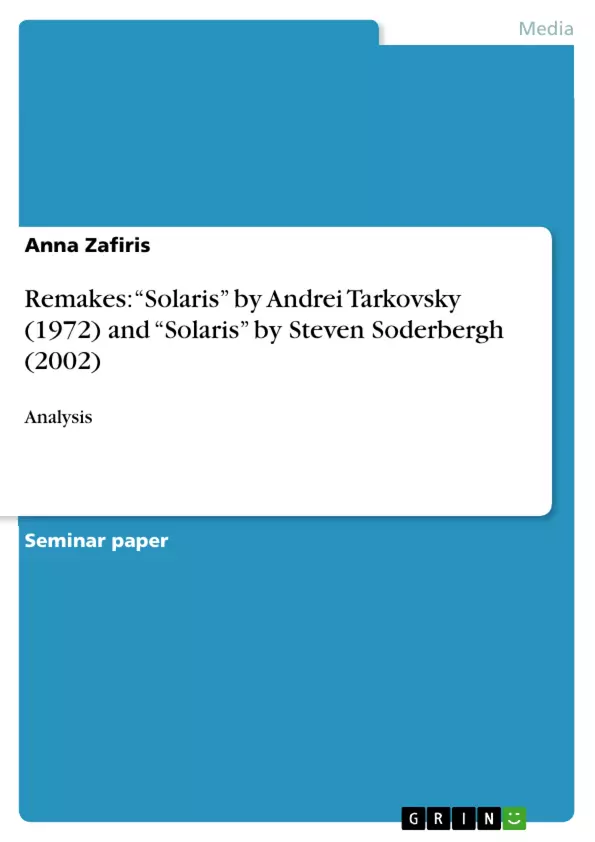Thom Patterson from CNN expresses the issue of the remake in a very nice way: „Remaking well-known films can be the Hollywood equivalent of replacing the family dog or a favourite bathrobe: sometimes only the old one will do and a replacement is unthinkable.”
In my case study I will take a closer look at the two different versions of
“Solaris”:
Andrei Tarkovsky’s “Solaris” (1972) and
Steven Soderbergh’s “Solaris” (2002)
Is Soderbergh’s “Solaris” a worthy representative, replacement or addition to Tarkovsky’s “Solaris” or is it just like Patterson describes it, unneeded like the replacement of the family dog? Is Tarkovsky’s “family dog” so well-known and respected that a new “family dog” would be redundant?
First of all, one should notice that both films are based on Stanislaw Lem’s book “Solaris”. At least that’s what one can read everywhere…but is this so? Is Soderbergh’s film a re-adaptation of Lem’s book or is it rather a remake of Tarkovsky’s film?
I would like to analyse in what way the two directors developed the characters in the film having the book “Solaris” as the basis.
By analysing the way, Soderbergh and Tarkovsky present the relationship between Hari/Rheya and Chris and how the two directors develop the characters, I will also try to find an answer to the question whether Soderbergh’s “Solaris” is a remake of Tarkovsky’s Solaris or a re-adaptation of Lem’s book.
What are the similarities and differences of the presentation of this relationship in the two films?
Soderbergh for example never personally said that his film is only a remake of Tarkovsky’s “Solaris” but also, or even more, a re-adaptation of Lem’s book.
This would exactly apply to the theory of Jan Speckenbach, who mentions in his first part of “On the Remake. A cinematic phenomenon” that sometimes the director of a remake denies it to be one. Since it might sell better when it is a new adaptation of the novel - that also is used in the original film - that provided a basis for the remake and not just a remake of the original film. But did Soderbergh only refer to his film as a re-adaptation because it might sell better or is it really a re-adaptation?
Hari/Rheya (named Hari in Tarkovsky’s “Solaris”, differently in Soderbergh’s “Solaris” and same as in Lem’s book: Rheya) also plays a central role in the two films, and I would like to analyse the representation of her in the two films.
Inhaltsverzeichnis (Table of Contents)
- Introduction
- I. Introduction into the Plot
- II. Analysis of the two Films with special Regard to the Characters
- The Visitors
- The Relationship between Hari/Rheya and Chris Kelvin
- Hari/Rheya
- Chris' Reaction to Hari's/Rheya's Disappearance
- How real are any of us?
- Marketing of "Solaris"
- 'Look' of "Solaris"
- The different Endings of the Films
- Tarkovsky's "Solaris"
- Soderbergh's "Solaris"
- Character drawing
- III. Remake or Re-adaptation?
- Conclusion
- IV. Works Cited
- V. Filmography
- VI. Overview: most important Characters of the Films
Zielsetzung und Themenschwerpunkte (Objectives and Key Themes)
This case study compares and contrasts the two film adaptations of Stanislaw Lem's novel "Solaris," directed by Andrei Tarkovsky (1972) and Steven Soderbergh (2002). The study explores the relationship between the films and their source material, analyzing how the directors develop the characters and their interactions, particularly focusing on the relationship between Hari/Rheya and Chris Kelvin. The study aims to determine whether Soderbergh's "Solaris" is a true remake of Tarkovsky's film or rather a re-adaptation of Lem's novel.
- The relationship between remakes, re-adaptations, and source material.
- The development of characters and their relationships in both film adaptations.
- The philosophical themes of identity, consciousness, and the nature of reality explored in both films.
- The different stylistic approaches of Tarkovsky and Soderbergh in their interpretations of "Solaris."
- The role of the "visitors" in both films and their significance in exploring the themes of memory, loss, and the unconscious.
Zusammenfassung der Kapitel (Chapter Summaries)
The introduction presents the case study's focus and discusses the concept of remakes, drawing on the perspective of Thom Patterson from CNN. It establishes the context for comparing Tarkovsky's and Soderbergh's "Solaris" films, questioning whether Soderbergh's film is a worthy replacement or addition to Tarkovsky's adaptation.
The chapter "Introduction into the Plot" provides a brief overview of the narrative structure of the films, setting the scene on the space station orbiting the planet Solaris. The chapter introduces the main characters and the mysterious phenomenon of the planet's intelligence and the visitors that appear on the station.
The chapter "Analysis of the Films with special Regard to the Characters" delves into the character development and the relationship between Hari/Rheya and Chris Kelvin in both films. It examines the visual presentation of the visitors and their role in reflecting the characters' inner worlds.
Schlüsselwörter (Keywords)
The primary keywords and focus topics of this case study include: remakes, re-adaptations, "Solaris" (novel), "Solaris" (Tarkovsky film), "Solaris" (Soderbergh film), Stanislaw Lem, Andrei Tarkovsky, Steven Soderbergh, characters, relationships, Chris Kelvin, Hari/Rheya, visitors, consciousness, identity, memory, loss, the unconscious, philosophical themes, stylistic differences.
- Citar trabajo
- Anna Zafiris (Autor), 2004, Remakes: “Solaris” by Andrei Tarkovsky (1972) and “Solaris” by Steven Soderbergh (2002), Múnich, GRIN Verlag, https://www.grin.com/document/143309



